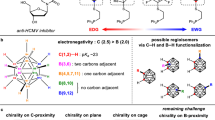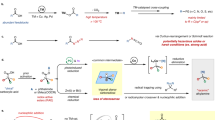Abstract
Developing a unified method that can construct almost all types of chiral centres has been an unrealized aspiration for synthetic chemists. Boron-mediated homologation can generate versatile boron-substituted stereocentres via asymmetric carbenoid insertion, potentially leading to diverse chiral centres. However, limitations of the current methods make it challenging to incorporate a wide range of functionalized carbenoids with high stereochemical control. Here we report an enantioconvergent approach for direct insertion of various carbon-, oxygen-, nitrogen-, sulfur- and silicon-substituted carbenoids into carbon–boron bonds of readily available boronic acid derivatives, which can then be transformed into a wide range of tertiary chiral centres. Excellent stereoselectivity was achieved and enabled by a class of chiral oxazaborolidines derived from inexpensive α-amino esters. Computational studies revealed that the non-C2-symmetric oxazaborolidine features a puckered geometry and the cooperative effects of multiple substituents create an asymmetric environment for effective enantioinduction. This method is scalable, and each chiral centre can be independently controlled by the chiral oxazaborolidine without being influenced by nearby stereocentres. In addition to forming singular chiral centres, iterative operations of this asymmetric homologation simplify syntheses of complex molecules with multiple stereocentres.

This is a preview of subscription content, access via your institution
Access options
Subscribe to this journal
Receive 12 digital issues and online access to articles
$119.00 per year
only $9.92 per issue
Buy this article
- Purchase on SpringerLink
- Instant access to full article PDF
Prices may be subject to local taxes which are calculated during checkout






Similar content being viewed by others
Data availability
The data supporting the findings of this study are available within the article and its Supplementary Information. The X-ray crystallographic coordinates for structures reported in this study have been deposited at the Cambridge Crystallographic Data Centre (CCDC), under deposition numbers 2311818 (9f) and 2312263 (27). These data can be obtained free of charge from the CCDC via www.ccdc.cam.ac.uk/data_request/cif.
References
Matteson, D. S. α-Halo boronic esters: intermediates for stereodirected synthesis. Chem. Rev. 89, 1535–1551 (1989).
Matteson, D. S. Boronic esters in asymmetric synthesis. J. Org. Chem. 78, 10009–10023 (2013).
Leonori, D. & Aggarwal, V. K. Lithiation–borylation methodology and its application in synthesis. Acc. Chem. Res. 47, 3174–3183 (2014).
Pace, V., Holzer, W. & Kimpe, N. D. Lithium halomethylcarbenoids: preparation and use in the homologation of carbon electrophiles. Chem. Rec. 16, 2061–2076 (2016).
Castoldi, L., Monticelli, S., Senatore, R., Ielo, L. & Pace, V. Homologation chemistry with nucleophilic α-substituted organometallic reagents: chemocontrol, new concepts and (solved) challenges. Chem. Commun. 54, 6692–6704 (2018).
Matteson, D. S., Collins, B. S. L., Aggarwal, V. K. & Ciganek, E. The Matteson reaction. Org. React. 105, 427–860 (2021).
Yeung, K., Mykura, R. C. & Aggarwal, V. K. Lithiation–borylation methodology in the total synthesis of natural products. Nat. Synth. 1, 117–126 (2022).
Pace, V. (ed.) Homologation Reactions: Reagents, Applications, and Mechanisms (Wiley, 2023).
Cherney, A. H., Kadunce, N. T. & Reisman, S. E. Enantioselective and enantiospecific transition-metal-catalyzed cross-coupling reactions of organometallic reagents to construct C–C bonds. Chem. Rev. 115, 9587–9652 (2015).
Sandford, C. & Aggarwal, V. K. Stereospecific functionalizations and transformations of secondary and tertiary boronic esters. Chem. Commun. 53, 5481–5494 (2017).
Xie, Q. & Dong, G. Aza-Matteson reactions via controlled mono-and double-methylene insertions into nitrogen–boron bonds. J. Am. Chem. Soc. 143, 14422–14427 (2021).
Xie, Q. & Dong, G. Programmable ether synthesis enabled by oxa-Matteson reaction. J. Am. Chem. Soc. 144, 8498–8503 (2022).
Xie, Q., Zhang, R. & Dong, G. Programmable amine synthesis via iterative boron homologation. Angew. Chem. Int. Ed. 62, e202307118 (2023).
Matteson, D. S. & Peterson, M. L. Synthesis of l-(+)-ribose via (S)-pinanediol (αS)-α-bromo boronic esters. J. Org. Chem. 52, 5116–5121 (1987).
Matteson, D. S., Kandil, A. A. & Soundararajan, R. Synthesis of asymmetrically deuterated glycerol and dibenzyl glyceraldehyde via boronic esters. J. Am. Chem. Soc. 112, 3964–3969 (1990).
Matteson, D. S., Man, H.-W. & Ho, O. C. Asymmetric synthesis of stegobinone via boronic ester chemistry. J. Am. Chem. Soc. 118, 4560–4566 (1996).
Blakemore, P. R. & Burge, M. S. Iterative stereospecific reagent-controlled homologation of pinacol boronates by enantioenriched α-chloroalkyllithium reagents. J. Am. Chem. Soc. 129, 3068–3069 (2007).
Burns, M. et al. Assembly-line synthesis of organic molecules with tailored shapes. Nature 513, 183–188 (2014).
Balieu, S. et al. Toward ideality: the synthesis of (+)-kalkitoxin and (+)-hydroxyphthioceranic acid by assembly-line synthesis. J. Am. Chem. Soc. 137, 4398–4403 (2015).
Wu, J. et al. Synergy of synthesis, computation and NMR reveals correct baulamycin structures. Nature 547, 436–440 (2017).
Gorges, J. & Kazmaier, U. Matteson homologation-based total synthesis of lagunamide A. Org. Lett. 20, 2033–2036 (2018).
Andler, O. & Kazmaier, U. Stereoselective synthesis of a protected side chain of meliponamycin A. Org. Lett. 24, 2541–2545 (2022).
Matteson, D. S. & Ray, R. Directed chiral synthesis with pinanediol boronic esters. J. Am. Chem. Soc. 102, 7590–7591 (1980).
Matteson, D. S. & Sadhu, K. M. Boronic ester homologation with 99% chiral selectivity and its use in syntheses of the insect pheromones (3S,4S)-4-methyl-3-heptanol and exo-brevicomin. J. Am. Chem. Soc. 105, 2077–2078 (1983).
Sharma, H. A., Essman, J. Z. & Jacobsen, E. N. Enantioselective catalytic 1,2-boronate rearrangements. Science 374, 752–757 (2021).
Jonker, S. J. et al. Organocatalytic synthesis of α-trifluoromethyl allylboronic acids by enantioselective 1,2-borotropic migration. J. Am. Chem. Soc. 142, 21254–21259 (2020).
Hiscox, W. C. & Matteson, D. S. An efficient preparation of (R,R)-1, 2-dicyclohexylethane-1,2-diol, a superior chiral director for synthesis with boronic esters. J. Org. Chem. 61, 8315–8316 (1996).
Matteson, D. S., Ray, R., Rocks, R. R. & Tsai, D. J. Directed chiral synthesis by way of α-chloro boronic esters. Organometallics 2, 1536–1543 (1983).
Aggarwal, V. K., Fang, G. Y. & Schmidt, A. T. Synthesis and applications of chiral organoboranes generated from sulfonium ylides. J. Am. Chem. Soc. 127, 1642–1643 (2005).
Stymiest, J. L., Dutheuil, G., Mahmood, A. & Aggarwal, V. K. Lithiated carbamates: chiral carbenoids for iterative homologation of boranes and boronic esters. Angew. Chem. Int. Ed. 46, 7491–7494 (2007).
Blakemore, P. R., Marsden, S. P. & Vater, H. D. Reagent-controlled asymmetric homologation of boronic esters by enantioenriched main-group chiral carbenoids. Org. Lett. 8, 773–776 (2006).
Sun, X. & Blakemore, P. R. Programmed synthesis of a contiguous stereotriad motif by triple stereospecific reagent-controlled homologation. Org. Lett. 15, 4500–4503 (2013).
Hoppe, D., Hintze, F. & Tebben, P. Chiral lithium-1-oxyalkanides by asymmetric deprotonation; enantioselective synthesis of 2-hydroxyalkanoic acids and secondary alkanols. Angew. Chem. Int. Ed. 29, 1422–1424 (1990).
Partridge, B. M., Chausset-Boissarie, L., Burns, M., Pulis, A. P. & Aggarwal, V. K. Enantioselective synthesis and cross-coupling of tertiary propargylic boronic esters using lithiation–borylation of propargylic carbamates. Angew. Chem. Int. Ed. 51, 11795–11799 (2012).
Ritter, S. K. Where has all the sparteine gone? Chem. Eng. News 95, 18–20 (2017).
Zuccarello, G., Batiste, S. M., Cho, H. & Fu, G. C. Enantioselective synthesis of α-aminoboronic acid derivatives via copper-catalyzed N-alkylation. J. Am. Chem. Soc. 145, 3330–3334 (2023).
Schmidt, J., Choi, J., Liu, A. T., Slusarczyk, M. & Fu, G. C. A general, modular method for the catalytic asymmetric synthesis of alkylboronate esters. Science 354, 1265–1269 (2016).
Matthew, S., Glasspoole, B. W., Eisenberger, P. & Crudden, C. M. Synthesis of enantiomerically enriched triarylmethanes by enantiospecific Suzuki–Miyaura cross-coupling reactions. J. Am. Chem. Soc. 136, 5828–5831 (2014).
Barsamian, A. L., Wu, Z. & Blakemore, P. R. Enantioselective synthesis of α-phenyl- and α-(dimethylphenylsilyl)alkylboronic esters by ligand mediated stereoinductive reagent-controlled homologation using configurationally labile carbenoids. Org. Biomol. Chem. 13, 3781–3786 (2015).
Chen, M., Tugwell, T. H., Liu, P. & Dong, G. Synthesis of alkenyl boronates through stereoselective vinylene homologation of organoboronates. Nat. Synth. 3, 337–346 (2024).
Bootwicha, T., Feilner, J. M., Myers, E. L. & Aggarwal, V. K. Iterative assembly line synthesis of polypropionates with full stereocontrol. Nat. Chem. 9, 896–902 (2017).
Pereira, C. L., Chen, Y.-H. & McDonald, F. E. Total synthesis of the sphingolipid biosynthesis inhibitor fumonisin B1. J. Am. Chem. Soc. 131, 6066–6067 (2009).
Matteson, D. S. & Man, H.-W. Hydrolysis of substituted 1,3,2-dioxaborolanes and an asymmetric synthesis of a differentially protected syn,syn-3-methyl-2, 4-hexanediol. J. Org. Chem. 61, 6047–6051 (1996).
Ghosh, S., Greenwood, J. R., Harriman, G. C. & Leit de Moradei, S. M. Triazole ACC inhibitors and uses thereof. International patent WO2017091617 A1 (2017).
Chandrasekhar, S. & Sreelakshmi, L. Formal synthesis of fumonisin B1, a potent sphingolipid biosynthesis inhibitor. Tetrahedron Lett. 53, 3233–3236 (2012).
Bonet, A., Odachowski, M., Leonori, D., Essafi, S. & Aggarwal, V. K. Enantiospecific sp2–sp3 coupling of secondary and tertiary boronic esters. Nat. Chem. 6, 584–589 (2014).
Edelstein, E. K., Grote, A. C., Palkowitz, M. D. & Morken, J. P. A protocol for direct stereospecific amination of primary, secondary, and tertiary alkylboronic esters. Synlett 29, 1749–1752 (2018).
Xu, N., Liang, H. & Morken, J. P. Copper-catalyzed stereospecific transformations of alkylboronic esters. J. Am. Chem. Soc. 144, 11546–11552 (2022).
Acknowledgements
We are grateful for financial support from the University of Chicago and the NIH (R35 GM128779, P.L.). We thank Z. Zhang, X. Liu, S. Anferov and A. Filatov for X-ray crystallography. We thank X. Liu for checking the experimental procedure. DFT calculations were carried out at the University of Pittsburgh Center for Research Computing and the Advanced Cyberinfrastructure Coordination Ecosystem: Services & Support (ACCESS) programme, supported by NSF award numbers OAC-2117681, OAC-1928147 and OAC-1928224.
Author information
Authors and Affiliations
Contributions
Q.X. and G.D. conceived of the idea and designed the experiments. Q.X. and J.L. conducted the experimental investigation. P.L., T.H.T. and M.C.M. conceived and designed the computational studies. T.H.T. and M.C.M. performed the computational studies. Q.X., T.H.T., P.L. and G.D. wrote the paper. P.L. and G.D. directed the research.
Corresponding authors
Ethics declarations
Competing interests
The authors declare no competing interests.
Peer review
Peer review information
Nature Synthesis thanks Per-Ola Norrby, Tian Qin and the other, anonymous, reviewer(s) for their contribution to the peer review of this work. Primary Handling Editor: Thomas West, in collaboration with the Nature Synthesis team.
Additional information
Publisher’s note Springer Nature remains neutral with regard to jurisdictional claims in published maps and institutional affiliations.
Extended data
Extended Data Fig. 1 Stereoretentive derivatizations of the homologation product.
Diverse tertiary chiral centres can be formed via versatile stereospecific transformations of the carbon−boron bond. NIS, N-iodosuccinimide; e.s., enantiospecificity.
Extended Data Fig. 2 Summary on how to choose the optimal chiral auxiliary.
The choice of the best auxiliary depends on the substrates and carbenoids employed. X, leaving group.
Supplementary information
Supplementary information
Experimental details, Supplementary sections 1–16, Figs. 1–13 and Tables 1–4.
Supplementary Data 1
Crystallographic data for compound 9f; CCDC reference 2311818.
Supplementary Data 2
Crystallographic data for compound 27; CCDC reference 2312263.
Rights and permissions
Springer Nature or its licensor (e.g. a society or other partner) holds exclusive rights to this article under a publishing agreement with the author(s) or other rightsholder(s); author self-archiving of the accepted manuscript version of this article is solely governed by the terms of such publishing agreement and applicable law.
About this article
Cite this article
Xie, Q., Tugwell, T.H., Madhusudhanan, M.C. et al. Enantioconvergent carbenoid insertion into carbon–boron bonds. Nat. Synth 4, 1297–1307 (2025). https://doi.org/10.1038/s44160-025-00836-1
Received:
Accepted:
Published:
Issue date:
DOI: https://doi.org/10.1038/s44160-025-00836-1



